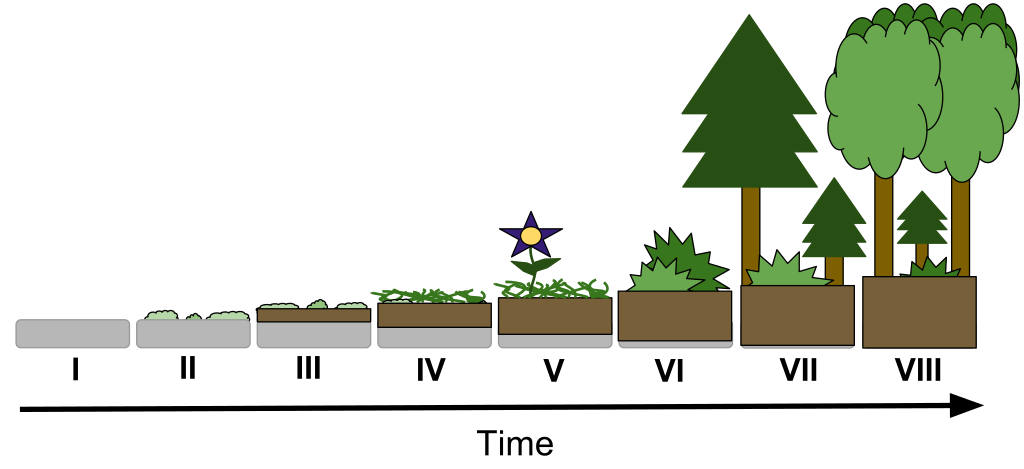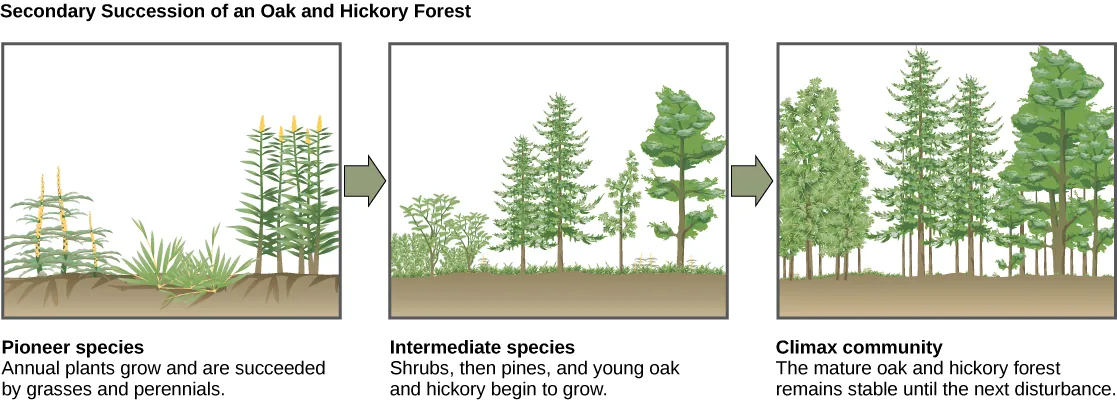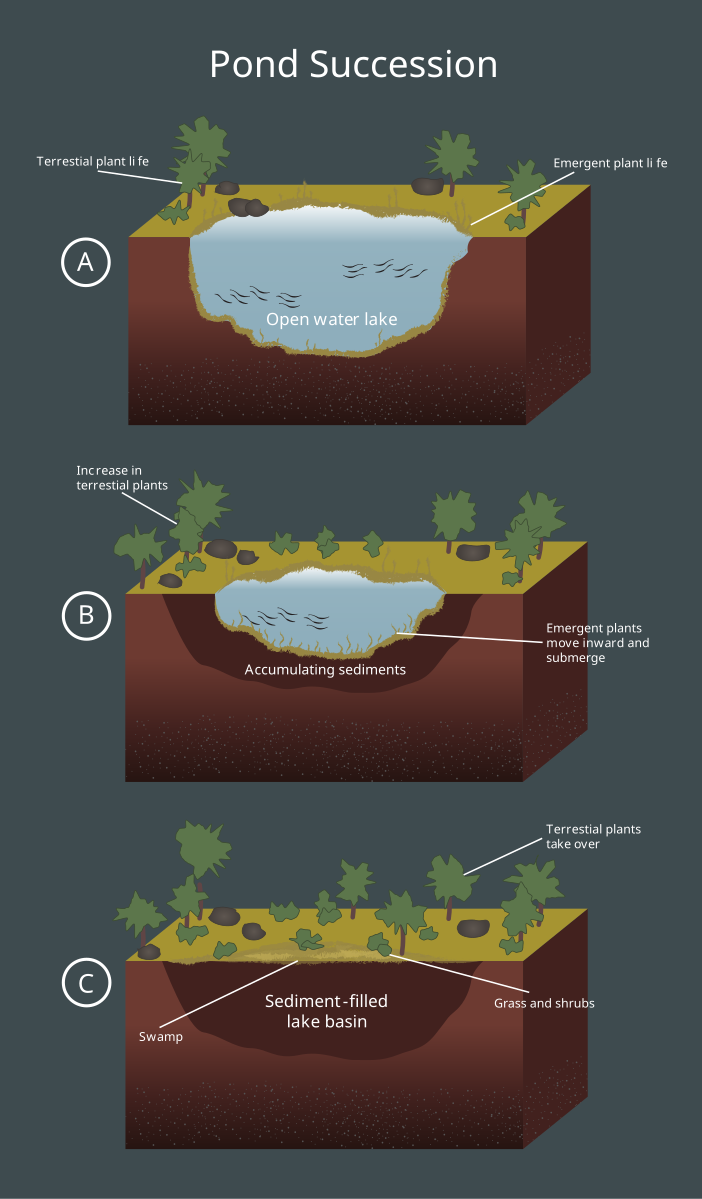IB Syllabus focus:
‘Each sere modifies conditions, enabling replacement through competition until a relatively stable climax community develops.’
Ecosystems undergo gradual, predictable transformations known as succession, in which species communities evolve through seral stages until reaching a more stable climax community. Understanding these stages provides insight into ecological resilience and long-term environmental change.
What are Seral Stages?
A seral stage represents one step in the progression of an ecosystem during succession. Each stage is characterised by specific species that dominate temporarily before being replaced by others.
Seral Stage: A phase in ecological succession where a particular community dominates, modifying conditions that allow subsequent species to establish.
Every seral stage alters abiotic and biotic conditions, making the environment either more suitable or less favourable for existing species, which then leads to competition and eventual replacement.
The Role of Competition
Competition is central to succession because species with different adaptations exploit resources differently. Over time, competition determines which species dominate and which are excluded.
Interspecific competition (between species) drives turnover of communities.
Intraspecific competition (within a species) regulates density and population structure.
These dynamics ensure that no single seral stage is permanent, as conditions change and new competitors take over.
Sequence of Seral Stages
Pioneer Stage
The first seral stage is usually occupied by pioneer species — hardy organisms that colonise bare or disturbed substrates.
Pioneer Species: The first organisms to colonise previously uninhabited or disturbed environments, capable of surviving in harsh abiotic conditions.
Typical pioneer species include lichens, mosses, and algae. They:
Break down rock into soil.
Add organic matter when they die, enriching the substrate.
Modify moisture and temperature conditions.

A clear schematic of primary succession from bare rock through lichens/mosses and shrubs to a forested climax community. It emphasises pioneer colonisation and the environmental changes that enable later seral stages. Includes stage labels I–VIII (extra labelling beyond the syllabus, but helpful for stepwise clarity). Source.
Intermediate Stages
Once soil begins to develop, grasses, herbs, and shrubs establish. These species:
Increase soil fertility through litter fall and decomposition.
Provide shade, reducing extremes in temperature.
Create habitats for insects and small animals.
In this phase, biodiversity rises sharply as niches multiply, and competition intensifies between plants and animals for resources such as light, nutrients, and space.
Late Seral Stages
Larger, longer-lived species such as trees dominate. This stage features:
Well-developed soils with complex nutrient cycles.
Stable populations of herbivores, carnivores, and decomposers.
Stronger vertical stratification of plant layers (canopy, understory, ground cover).
As stability increases, turnover slows, leading toward a climax community.

Three-panel diagram of secondary succession in an oak–hickory forest showing pioneer species, intermediate species, and the climax community. The sequence directly maps to seral stages and the approach to relative stability under constant climate and soils. Labels are concise and non-cluttered for instructional clarity. Source.
The Climax Community
The climax community is the final, relatively stable stage of succession under a given set of climatic and geographic conditions.
Climax Community: The final stage of ecological succession where species composition becomes relatively stable, shaped by long-term climate and soil conditions.
Characteristics of climax communities include:
High species diversity compared with earlier stages.
Complex food webs and strong trophic interactions.
Efficient nutrient cycling and energy flow.
Stability over long timescales, unless disrupted by human activity or natural disturbance.
Although stable, a climax community is not entirely static — minor fluctuations occur, but the overall composition tends to persist.
Examples of Seral Progression
Temperate forest succession:
Bare ground → lichens/mosses → grasses → shrubs → deciduous trees → mixed hardwood forest.
Sand dune succession:
Bare sand → marram grass → shrubs → woodland.
Pond succession:
Open water → aquatic plants → marsh → meadow → woodland.
Each example illustrates how one sere modifies conditions, creating opportunities for the next stage.

Labeled hydrosere diagram depicting succession from open water with emergent plants to marsh and meadow as organic matter and sediments infill the basin. This visual reinforces how each sere alters abiotic conditions to enable replacement. The figure includes brief notes on sedimentation—additional detail that is consistent with the syllabus focus on environmental change across stages. Source.
Key Features of Succession through Seral Stages
Abiotic Changes
Soil depth and nutrient availability increase.
Moisture retention improves.
Microclimates form, reducing exposure to wind and temperature extremes.
Biotic Changes
Greater species diversity at higher seral stages.
Stronger community interactions (e.g., predation, mutualism, parasitism).
Growth of complex food webs.
Energy and Nutrient Flow
Primary productivity rises initially, then stabilises.
Biomass accumulation increases with vegetation complexity.
Nutrient cycling becomes more efficient in later stages.
Factors Affecting Succession Rate
The speed of progression from one seral stage to another depends on:
Climate: Warm, moist climates accelerate succession.
Soil type: Poor soils slow progression.
Disturbance: Fire, storms, and human activities can reset succession.
Species traits: Adaptations of pioneer and competitive species influence turnover rates.
Human Influence
Human activities can interrupt or alter seral progression. Intensive grazing, deforestation, or urbanisation may prevent succession from reaching a climax community, maintaining ecosystems in earlier seral stages. This results in a plagioclimax, where human influence maintains an alternative stable state.
FAQ
The length of each seral stage is affected by both abiotic and biotic conditions.
Key factors include:
Soil fertility and depth, which influence plant colonisation rates.
Climate variables such as temperature, precipitation, and sunlight.
Disturbances like fire, flooding, or grazing that can reset succession.
Presence or absence of keystone species that shape community dynamics.
In primary succession, seral stages begin on bare substrate with no soil, so development is slower. Pioneer species like lichens and mosses are essential.
In secondary succession, soil and seed banks are already present. Seral stages progress more rapidly, with grasses, herbs, and shrubs establishing quickly before trees dominate.
Yes, climax communities are region-specific because they are shaped by local climate and soil conditions.
Examples:
Temperate regions often support deciduous or mixed forests.
Tropical regions develop rainforest climax communities.
Arid regions stabilise as desert scrub communities.
Decomposers recycle nutrients by breaking down organic matter. Their activity increases as succession advances.
Early stages: limited role due to low organic input.
Intermediate stages: rising importance as plant and animal litter accumulates.
Late stages: essential for maintaining nutrient cycling within complex food webs.
Climax communities are stable over long timescales but remain dynamic.
Minor fluctuations occur due to seasonal variations, small-scale disturbances, and species interactions. These do not alter the overall structure significantly but highlight that no ecosystem is entirely static.
Practice Questions
Question 1 (2 marks)
Define the term seral stage and explain its role in ecological succession.
Mark scheme:
Definition of seral stage: a phase in succession where a particular community dominates temporarily (1 mark).
Explanation that it modifies abiotic or biotic conditions, enabling replacement by other species (1 mark).
Question 2 (5 marks)
Discuss how competition influences the progression from pioneer species to a climax community during succession.
Mark scheme:
Description of pioneer species establishing in harsh abiotic conditions (1 mark).
Explanation of how pioneers alter the environment, e.g. adding organic matter, improving soil, creating shade (1 mark).
Interspecific competition described as driving community turnover (1 mark).
Intraspecific competition described as regulating density and population structure (1 mark).
Link to climax community as a relatively stable stage shaped by long-term conditions, achieved through successive competitive replacements (1 mark).

